Steppe almond and its cultivation

It is quite possible to grow steppe almonds on your own plot. At first, it will delight you with a bright appearance, and then it will allow you to use seeds to produce useful oil.
Description
Steppe almonds are also referred to as low, dwarf or bean almonds. This shrub is a member of the Pink family and the Plum genus. The specificity of the plant is that all its parts are poisonous. The height of the deciduous plant does not exceed 1.5 m. The powerful root system of the culture keeps it even on stony slopes. The lush crown is formed from thin long stems. Leaf blades of a linear-lanceolate or elliptical shape are painted in a dark green hue, and large buds have a bright pink color and a bitter aroma.
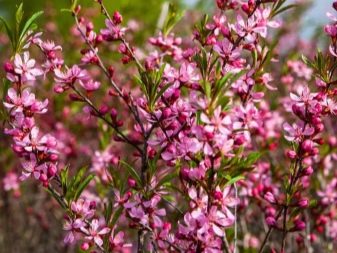

The flowering of the culture, by the way, begins even 2 weeks earlier than the blooming of the leaf blades - approximately in April. According to the "formula" of a flower, one can understand that one pistil has a large number of stamens. The cup, 3-4 millimeters long, resembles a cylinder and has blunt teeth. Flowers, the diameter of which reaches 4 centimeters, either grow separately, or they cluster 2-3 pieces in the leaf axils. The bean fruit is a tomentose-shaggy drupe 1-2 centimeters long, inside which there are bones compressed from the sides.
Steppe almonds are cultivated for decorative purposes, and the seeds contained in its fruits are used in cooking and medicine. The fruits of steppe almonds, unlike ordinary almonds, are not allowed to be eaten. The culture is characterized by the ability to tolerate the lack of watering, frost resistance and unpretentiousness to living conditions. However, lighting is extremely important for her - in dark places the plant will die.
There are two main forms of bean plants: white-flowered and Gessler.
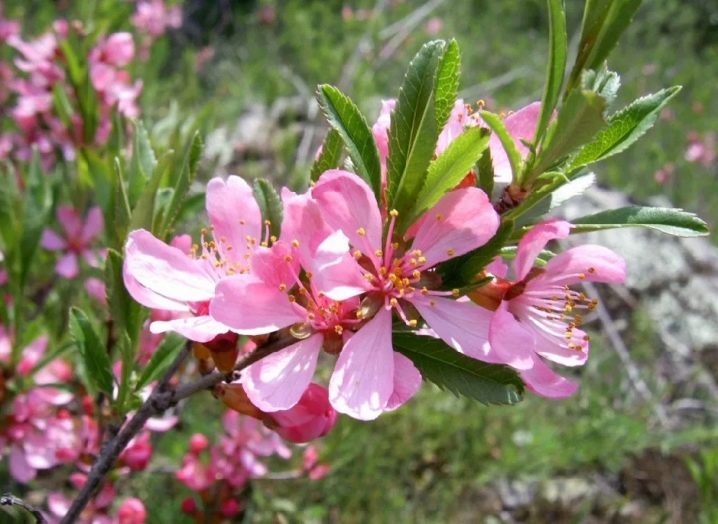
Landing
It is customary to plant steppe almonds in the fall, waiting for the end of the leaf fall. Spring planting is also allowed, organized at a time when the probability of return frosts becomes zero, and the temperature turns out to be stably warm. However, the first option is still considered more preferable. It is recommended to locate the bean in an open, well-lit southern area. The composition of the soil for the culture is not particularly important, but the soil should be neutral, with a pH level within the range of 4.5–7.5. Almonds will feel good on sandy stones and loams, but they will not like the nearby groundwater.
Before being transferred to the open ground, the roots of the seedlings are disinfected in a weak manganese solution. For spring planting, it is advised to use a clay mash in order to retain the moisture in the plant to the maximum. The hole must be more than 30 centimeters deep. If you plan to land several copies, then the distance between them is left equal to 3-5 meters, and between the rows - about 5 meters. At the bottom of the recess, a drainage layer of rubble or pieces of brick 20 centimeters thick is necessarily formed. Sand crumbles on top of it, forming a five-centimeter layer, and a high peg is driven into the middle of the hole for further garter of the seedling.
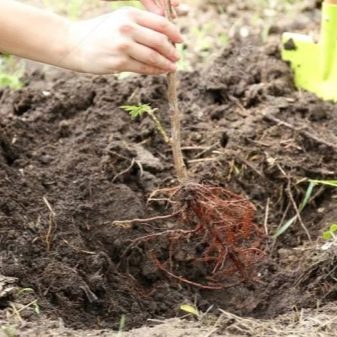
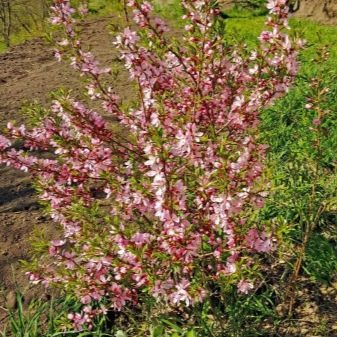
The procedure is organized either early in the morning or in the afternoon.The almond seedling is neatly placed in the hole, its roots are straightened and covered with a mixture of top soil, sand and humus. The root collar should rise slightly above the ground. Upon completion, each seedling is irrigated with a bucket of water and mulched with peat or dry soil.
Care
Caring for steppe almonds is not particularly difficult.
Watering and feeding
Despite the fact that the plant is able to survive a drought, it will still have to be watered. Irrigation is carried out regularly, but in moderation, using a soft settled or rain liquid. On average, the frequency of the procedure is 1 time per week, and about 1 bucket of water is used for each bush. During flowering, irrigation becomes more abundant. Ideally, the procedure is organized in the evening. It is recommended to accompany it by loosening. If almonds live among young animals, then the instrument deepens by 5-7 centimeters, and if among adult specimens - by 8-10 centimeters.
You can feed legumes with organics and mineral complexes. In the fall, organic matter is usually introduced - for example, rotted manure. In spring, the crop will respond better to a mixture of 30% sodium, 60% phosphorus and 10% potassium. Another scheme involves the use of 20 grams of superphosphate in the fall and the same amount of potassium sulfate. In the spring months, by contrast, dung, mullein, or a combination of 20 grams of ammonium nitrate, 10 grams of urea and a bucket of water are more suitable. Nutrient mixtures are distributed around the bush at a distance of about 50 centimeters from the trunk.
Steppe almonds have to be cleaned of weeds in a timely manner, as well as mulch.
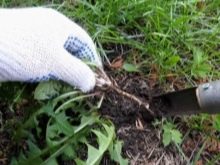
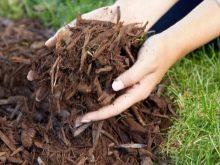
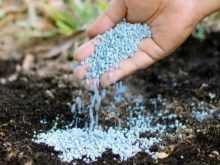
Pruning
Ornamental almonds are pruned regularly. In early spring, until sap flow begins, all frozen, diseased or damaged branches are removed. Those shoots that provoke thickening should also be removed. When the shrub finishes flowering, it will be necessary to carry out its formation. For this, faded branches are completely removed, as well as those that develop in the wrong direction. When the plant reaches the age of seven, all old shoots will need to be removed from it.
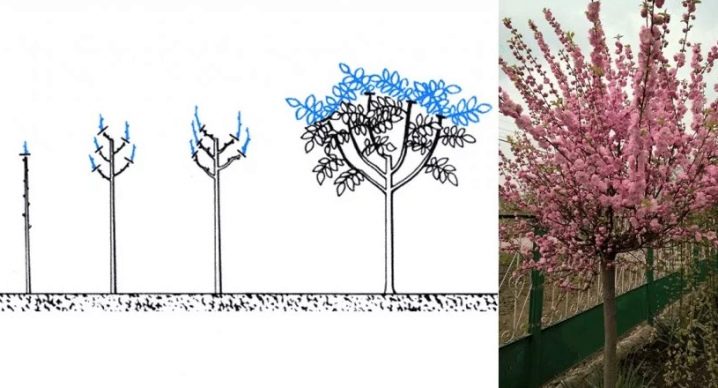
Wintering
Before the onset of the cold season, the tops of the stems are pinched off the almonds to accelerate the lignification process. Young seedlings are additionally protected with dry foliage or straw with a layer 15 centimeters thick. Such shelter is not required for adult specimens.

Reproduction
It will be possible to propagate steppe almonds both by seeds and by a vegetative method. In the first case, the material is necessarily stratified for 60 days in the refrigerator. Immediately before planting, it is kept for some time in moist sand at an average temperature. To obtain seedlings, the grains are planted in a mixture of sand and peat under cling film or glass. The container is placed in a room where the temperature is maintained from +18 to +20 degrees. Future nuts will appear only after 2-3 months. When they get stronger, it will be possible to start hardening them, however, landing on an open area will be made only the next year.
Reproduction of the culture can be carried out by grafting. As a stock, it is better to use frost-resistant almonds, cherry plums, bird cherry or plum - a straight tree with well-developed stems covered with eyes. A stalk, peeled of foliage, is left with only short centimeter petioles. Vaccination is carried out at the time when the movement of juices is observed in the almonds, that is, in spring or in August. The stock is wiped with a damp cloth, after which a T-shaped incision is made on it with a special knife, the bark is removed. A strip of bark with a bud and a thin layer of wood is cut from the scion. The graft and rootstock are combined, and the turned-off fragments of their bark are fixed with tape or plaster. In this case, the kidney is left unclosed.
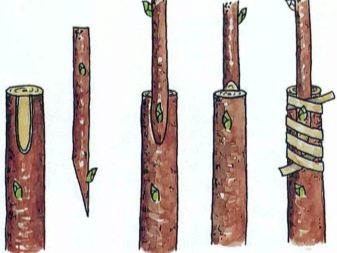
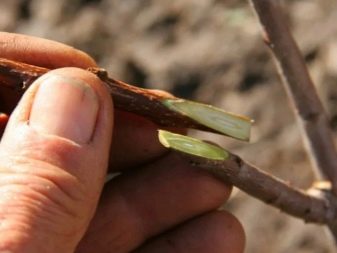
Suitable for steppe almonds and cuttings. The twigs are harvested in the second half of June. For reproduction, the tops of the shoots 15-20 centimeters long are taken, on which there are 2 nodes each. For 24 hours, the cuttings are immersed in a stimulating solution, and then rooted in a cold greenhouse using peat and sand, taken in a 2: 1 ratio. Growing cuttings is carried out already in a permanent habitat.
Root shoots for reproduction are taken from the most developed bushes. The offspring are separated from the root in the spring, and only those fragments are taken that have either a dormant bud or a formed young shoot. The opened wounds are immediately sprinkled with crushed charcoal. The new plant is immediately planted in open ground. Another breeding method involves the use of layering. A flexible and long shoot is selected from the bush, and an incision is made in the place where it touches the ground. The place is sprayed with a stimulating drug, and the branch is instilled to a depth of 10 centimeters.
The young plant is separated from the mother plant only after 2 years.
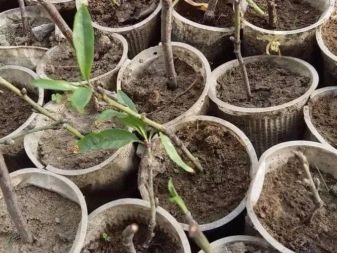
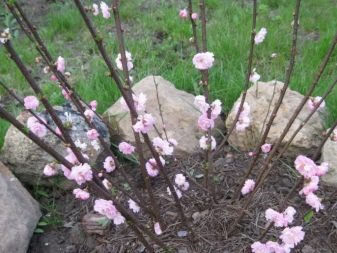
Diseases and pests
Steppe almonds often suffer from attacks by rapidly multiplying aphids, which not only feed on green mass, but also carry various diseases to the bush. Fighting an insect is obtained using folk recipes: infusion of dandelions or potato tops. When a plant becomes infected with gray rot, its leaf blades become covered with brown specks, and after rains - even a whitish bloom. Only a fungicide can cope with this fungal disease. In a rainy summer, the bean plant often becomes infected with clasterosporium disease, as evidenced by numerous specks on the leaves and fruits. This disease is also treated only with store-bought fungicides.
The spring whitewashing of the trunk with lime protects the almonds from bark beetles, and spraying with soapy water from the spider mite. As a preventive measure, it is recommended to regularly prune almond shrubs and spray with Bordeaux liquid. Withering of leaf blades and the appearance of various spots often indicate a lack of nutrients, and putrefactive processes - an excess of moisture. In a diseased plant, the damaged parts are always cut off and destroyed.
It is recommended to accompany the treatment by digging the beds and burning the old foliage remaining on the site.
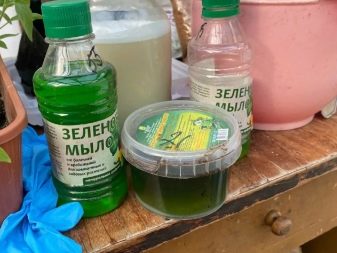
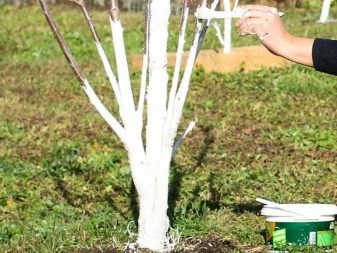
Application in landscape design
Steppe almonds are widely used in landscape design. The culture can become part of a hedge or it can turn out to be a bright tapeworm of a garden plot. Flowering bushes organically fit into the composition of the alpine hills, being planted against the background of coniferous trees. A compact plant looks good in small open areas and in rockeries, it can also become a background for perennial flowers or take a place in the background in mixborders.
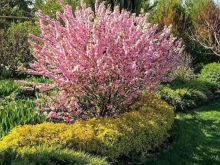
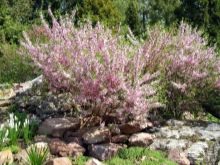
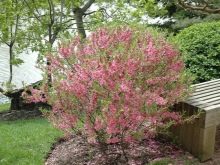



































































The comment was sent successfully.